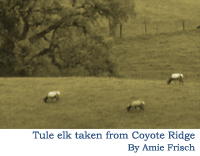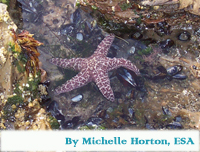Location: Letter from the Local Host
As the local host for the 2007 ESA /SER Joint Meeting, I warmly welcome you to the City of San Jose downtown area, to the San Jose State University campus, and to the fantastically biodiverse region in which we are located.
The city of San Jose has a rich history and cultural background, an idyllic climate, and it is located in the center of the California floristic province, the richest biodiversity hotspot in the continental United States.
 The city itself is transected by two rivers: the Guadalupe and Coyote creek, and it borders the San Francisco Bay. Thriving indigenous Muwekma Ohlone Indian communities first inhabited the banks of these waterways over 12,000 years ago, possible contemporaries of the last of the Columbian mammoths. European presence dates back to 1777, when El Pueblo de San Jose de Guadalupe became the first secular Spanish agricultural town in Nueva California . In 1849, San Jose was chosen as the first Capitol of the U.S. State of California, and in 1877 the first institution of higher learning in California was established here, later to become San Jose State University.
The city itself is transected by two rivers: the Guadalupe and Coyote creek, and it borders the San Francisco Bay. Thriving indigenous Muwekma Ohlone Indian communities first inhabited the banks of these waterways over 12,000 years ago, possible contemporaries of the last of the Columbian mammoths. European presence dates back to 1777, when El Pueblo de San Jose de Guadalupe became the first secular Spanish agricultural town in Nueva California . In 1849, San Jose was chosen as the first Capitol of the U.S. State of California, and in 1877 the first institution of higher learning in California was established here, later to become San Jose State University.
 In recent decades, this region has experienced staggering human population growth. As recently as the 1930's, the Santa Clara Valley was known as the “Valley of Heart's Delight,” for its world-renowned stone fruit orchards. San Jose still had a largely agricultural population of less than 58,000. By 1955, the human population of San Jose almost doubled, to 113,000. Over the next 5 decades, in parallel with the growth of the computer industry, the city of San Jose has developed into a metropolis of over 950,000 residents, the 3 rd largest city in the state of California. The surrounding Santa Clara Valley, aka “ Silicon Valley,” has grown to over 1.7 million human inhabitants in the same period. With the human and technological growth, of course, came a wide array of ecological challenges.
In recent decades, this region has experienced staggering human population growth. As recently as the 1930's, the Santa Clara Valley was known as the “Valley of Heart's Delight,” for its world-renowned stone fruit orchards. San Jose still had a largely agricultural population of less than 58,000. By 1955, the human population of San Jose almost doubled, to 113,000. Over the next 5 decades, in parallel with the growth of the computer industry, the city of San Jose has developed into a metropolis of over 950,000 residents, the 3 rd largest city in the state of California. The surrounding Santa Clara Valley, aka “ Silicon Valley,” has grown to over 1.7 million human inhabitants in the same period. With the human and technological growth, of course, came a wide array of ecological challenges.
 Despite the burgeoning human population, the natural history of this region remains stunning. The rivers of the Santa Clara Valley are still home to federally protected Coho salmon and steelhead, they serve as wildlife corridors between the surrounding hills and the bay, and they are the sites of numerous riparian restoration projects. The Baylands at the north end of the Valley is the site of the largest tidal marsh restoration on the West Coast. Further North lies the Golden Gate, sand dune restoration at the San Francisco Presidio, and the Coast Redwoods of Muir Woods. The Diablo mountain range to the east of the Valley is dominated by grasslands and California live oak woodlands, and its unique serpentine soils support a host of rare endemic plant and animal species, including the endangered Bay Checkerspot butterfly. The Santa Cruz Mountains, to the west, are renowned for their stunning coast redwood groves, but they are also home to nearly 1,800 other plant species, 400 vertebrate species and multiple federally and state listed invertebrates, found in pockets of endemism such as the Zayante sand hills ecosystem. To the south of San Jose lies Steinbeck's fabled central coast and Salinas Valley, now home to some of the most innovative agricultural ecosystems in the United States.
Despite the burgeoning human population, the natural history of this region remains stunning. The rivers of the Santa Clara Valley are still home to federally protected Coho salmon and steelhead, they serve as wildlife corridors between the surrounding hills and the bay, and they are the sites of numerous riparian restoration projects. The Baylands at the north end of the Valley is the site of the largest tidal marsh restoration on the West Coast. Further North lies the Golden Gate, sand dune restoration at the San Francisco Presidio, and the Coast Redwoods of Muir Woods. The Diablo mountain range to the east of the Valley is dominated by grasslands and California live oak woodlands, and its unique serpentine soils support a host of rare endemic plant and animal species, including the endangered Bay Checkerspot butterfly. The Santa Cruz Mountains, to the west, are renowned for their stunning coast redwood groves, but they are also home to nearly 1,800 other plant species, 400 vertebrate species and multiple federally and state listed invertebrates, found in pockets of endemism such as the Zayante sand hills ecosystem. To the south of San Jose lies Steinbeck's fabled central coast and Salinas Valley, now home to some of the most innovative agricultural ecosystems in the United States.
During your visit to San Jose this year, I strongly encourage you to get out of the Convention Center and explore all of these riches.
The downtown area is full of walking alleys, restaurants and entertainment and sights. Visit San Jose State University and the new city hall. Walk to San Pedro Square for outdoor film screenings and a farmers' market. Visit museums and take your kids to the riverpark. Go to dinner and the theater. Bring a bike to travel the paths along riparian corridors or get on the light rail to visit the rest of the valley. And especially, join ESA field trips to some of the natural wonders that surround us.
Update: 18th Comcast San Jose Jazz Festival, August 10-12, 2007.
www.sanjosejazz.org.

And again, welcome to San Jose!
Rachel O'Malley
ESA /SER Joint Meeting Local Host Chair
Environmental Studies
San Jose State University
Click here for more information on San Jose.